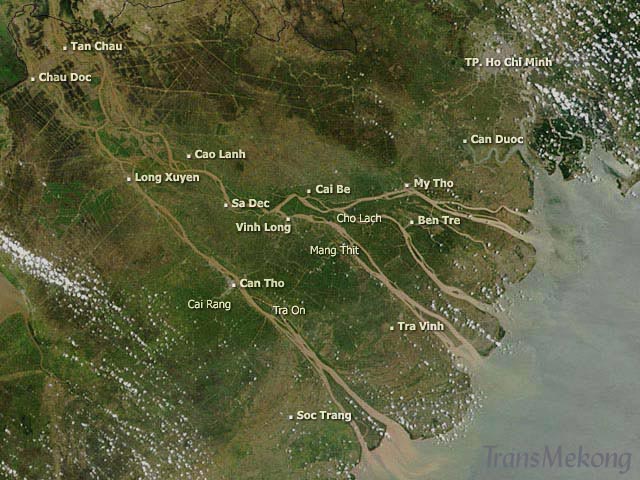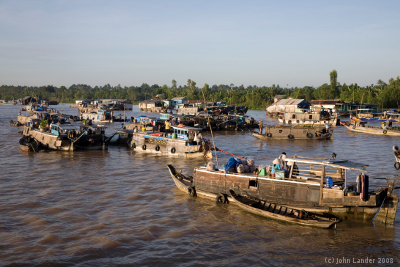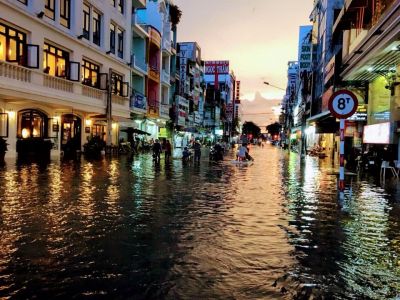
Đồng bằng Sông Cửu Long
Xem thêm Traces of history về địa lý của đồng bằng sông Cửu Long trong hơn 160 năm.
Vùng đồng bằng sông Cửu Long là vùng cực nam của Việt Nam, toạ lạc về hướng Tây Nam của thành phố Hồ Chí Minh - nơi nằm trên một lưu vực sông khác. Sông Mekong chảy vào Việt Nam theo hai nhánh, bao gồm: Sông Tiền (Tiền Giang) và sông Hậu (sông Bassac, Hậu Giang). Sông Tiền có một vài tên gọi khác trên đường chảy của sông, bắt đầu từ Vĩnh Xương và chảy qua Tân Châu, Cao Lãnh, Sa Đéc, đến gần Cái Bè và Mỹ Tho trước khi đổ ra biển. Sông Bassac chảy từ Campuchia vào phía Bắc Châu Đốc, qua Long Xuyên, Cần Thơ và gần Sóc Trăng trước khi đổ ra biển tại Cửa Định An.
Cuộc sống trên đồng bằng sông Cửu Long
Cuộc sống ở vùng nông thôn chủ yếu xoay quanh dòng sông, cùng hệ thống vô số các kênh rạch và các nhánh sông. Đánh bắt cá không chỉ là một nghề chính trong vùng, nghề này chủ yếu được thực hiện bằng nghề đan lưới và ở quy mô của cả một làng, mà từ vài thập kỷ nay, cư dân vùng đồng bằng bắt đầu nuôi cá trong các bè cá nổi, lúc đầu là ở tỉnh An Giang, phía Bắc sông Bassac, hiện nay càng ngày càng phát triển về phía hạ lưu. Sự phát triển gần đây nhất là nuôi trồng thuỷ sản trong ao, có thể là tôm thẻ, tôm càng hoặc tôm sú, cua và bây giờ là một số loại cá. Cảnh quan bắt đầu thay đổi sâu sắc trong vùng lân cận của các nông trại này.
The river and its tributaries form a dense net of waterways, of which near 15,000 miles can be navigated by boats of over 100 tons in the delta alone, that is more than ten times the length of compacted road. So all the markets are near the river, and West of the Bassac, they are often afloat on the river itself, be it wholesale markets like that of Cái Răng, near Cần Thơ, or retail markets or even village markets like at Trà Ôn.
All the trades pertaining to the river are represented along the banks, where you find not only agriculture producers, fruit drying facilities and small-scale cane sugar refineries, but also mechanics, wooden ship building yards and dry docks.
Threats from the sea
Roughly one half of the delta, North of Cần Thơ, is often flooded about the fall equinox as fresh water cannot freely flow out at sea, and the other half is less flooded, but more and more subject to the effects of saltwater from the sea. The lanscapes are thus very varied, from wide open ridefields to mangrove through coconut groves. The mean altitude of the delta is so low that the sea tides are not only felt but the current actually inverts as far North as Châu Đốc.
To the left, the Nam Bộ Boutique Hotel, still barely dry.
The delta produces more than half the total agricultural produce of Vietnam, and is dubbed the “Rice basket of Vietnam”. It is a very pleasant area to live, with a bountiful nature and charming people. Its being threatened by an increase in the water levels linked to global climate change makes the delta all the more precious today.
Wildlife of the Mekong delta
There are mosquitoes in the delta, but they are not very numerous are the water is typically not stagnant, and less so on board, as we are away from the banks. We still advise the passengers to use mosquito repellent, and when on board, simply to close the windows and doors at night in the rainy season.
The spiders and arachnids in the delta are common. They may be large, but they are typically harmless, the larger species to be commonly found are insect trappers that can be seen in their webs between bamboos, branches or electric wires. Scorpions happen and can cause painful swellings.
There may sometimes be small leeches in the rice fields, that may attach to one's skin. Although this is rare and we do not typically enter any rice fields and stay on firm ground, the passengers should simply take their shoes off upon boarding back and check for leeches. Should there be one, do not pull it off, but advise a member of the crew who will take care of you. Properly taken care of, they are mostly harmless.
Another potential risk is the rove beetle, or paederus, similar to the Nairobi fly, that may come out with the rain. Although it does not bite or sting, it can cause serious local blisters on the skin if it is crushed or threatened, so you should just blow it off. The rove beetles may be one or two centimeters long; to some people they look like ants although they are more fluid, and they are attracted to light.
Domestic animals
Poultry is farmed extensively in the delta, which was a vector of spreading the avian flu, and although this illness has to this date failed to degenerate into a human pandemic, it is still present in the delta. We advise our passengers to simply avoid contact with the poultry and their direct living area when they come across such farming.
Domestic dogs sometimes may defend their territory or that of their masters and a dog bite could happen. As there is a low but real risk of rabies, in case of a dog bite, we would then take the passengers to a hospital upon arrival to take anti-rabies shots within 24 hours.
Our classic itineraries
Our typical journeys are mostly from Cần Thơ on the Bassac to Cái Bè near the First River or back, crossing one large tributary, the Cổ Chiên river, but mostly remaining on the smaller, windier river Măng Thít and the Nicolai and Chợ Lách canals, where we have close encounters with life around the river. We also operate weekly two-night trips from Cái Bè to Cần Thơ then upstream the Bassac to Châu Đốc, then back to Cái Bè, an opportunity to link with Cambodia, but also to see the sceneries of the wider river.






